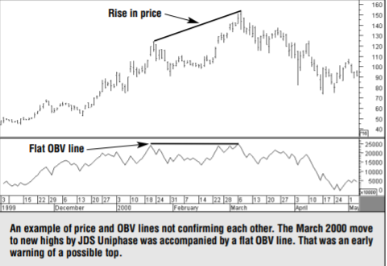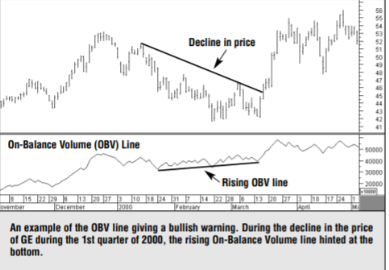- Study
- Slides
- Videos
4.1 Introduction

Volume tells us a story too. It’s like the Great Confirmer. Remember, Charles Dow considered volume as a confirmation of a change in trend. Chartists employ a two-dimensional approach to market analysis that includes a study of price and volume. Of the two, price is the more important. However, volume provides important secondary confirmation of the price action on the chart and often gives advance warning of an impending shift in trend.
Volume is the number of units traded during a given time period, which is usually a day. It is the number of common stock shares traded each day in the stock market. Volume can also be monitored on a weekly basis for longer-range analysis.
When used in conjunction with the price action, volume tells us something about the strength or weakness of the current price trend. Volume measures the pressure behind a given price move. As a rule, heavier volume (marked by larger vertical bars at the bottom of the chart) should be present in the direction of the prevailing price trend. During an uptrend, the heavier volume should be seen during rallies, with lighter volume (smaller volume bars) during downside corrections. In downtrends, the heavier volume should occur on price selloffs. Bear market bounces should take place on a lighter volume.
4.2 Volume Is an Important Part of Price Patterns

Volume also plays an important role in the formation and resolution of price patterns. Each of the price patterns described previously has its own volume pattern. As a rule, volume tends to diminish as price patterns form. The subsequent breakout that resolves the pattern takes on added significance if the price break-out is accompanied by heavier volume. Heavier volume accompanying the breaking of trend lines and support or resistance levels lends greater weight to price activity.
4.3 On-Balance Volume (OBV)
Market analysts have several indicators to measure trading volume. One of the simplest, and most effect, is on-balance volume (OBV).OBV plots a running cumulative total of upside versus downside volume. Each day that a market closes higher, that day’s volume is added to the previous total. On each down day, the volume is subtracted from the total. Over time, the on-balance volume will start to trend upward or downward. If it trends upward, that tells the trader that there’s more upside than downside volume, which is a good sign. A falling OBV line is usually a bearish sign
Plotting OBV-The OBV line is usually plotted along the bottom of the price chart. The idea is to make sure the price line and the OBV line are trending in the same direction. If prices are rising, but the OBV line is flat or falling, that means there may not be enough volume to support higher prices. In that case, the divergence between a rising price line and a flat or falling OBV line is a negative warning.
OBV Breakouts
During periods of sideways price movement, when the market trend is in doubt, the OBV line will sometimes break out first and give an early hint of future price direction. An upside breakout in the OBV line should catch the trader’s eye and cause him or her to take a closer look at the market or stock in question. At market bottoms, an upside breakout in on-balance volume is sometimes an early warning of an emerging uptrend.




